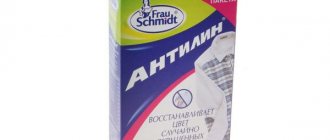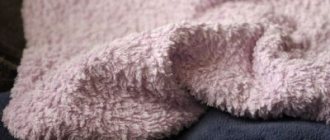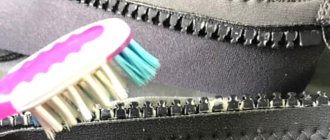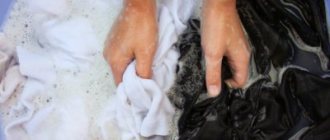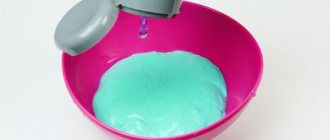A faded white item is a serious problem that even the most experienced housewife can face.
It is enough not to notice a small colored handkerchief for all snow-white clothes to acquire an uncharacteristic shade.
If such a situation occurs, there is no need to panic. There are effective and inexpensive ways to bleach faded whites, but you need to use them correctly.
So, what should you do if a white item has faded after washing, how can you return it to its former whiteness and original appearance, rather than bleach it and remove the foreign color? Find answers to your questions in the article.
How to return the previous look and color?
If the problem was noticed immediately after an unsuccessful wash, then you need to start fixing it immediately.
Waiting for clothes to dry is not recommended. Moreover, you can’t pet her. The soleplate of the iron will seal the paint securely into the fabric, and it will not be possible to remove it.
First, you need to try washing your clothes again, eliminating the item that caused the shedding . The water temperature should be maximum, but not exceed the recommended values. Information about this is indicated on the product label.
You need to use powder for washing white clothes. It contains bleaching components that help remove foreign pigment from fabric fibers.
If after normal washing the white item does not return to its original state, you need to use heavy artillery in the form of folk remedies and household chemicals. Read about washing white clothes here.
How to whiten with folk remedies?
You can bleach faded white fabric by boiling it in a soap-soda solution. It is prepared as follows:
- rub 40 g of laundry soap 72% (this is approximately ½ bar);
- heat 5 liters of water;
- add 15 g of soda to it;
- Mix all components thoroughly until they are completely dissolved.
You need to boil things for at least an hour. The container must be made of stainless steel. An enamel bucket or pan is also suitable.
During processing, things need to be stirred and heated. When the procedure is completed, the soap solution is drained and the clothes are rinsed in cool water. If it was not possible to bleach the fabric the first time, the procedure must be repeated.
There are other, no less effective folk remedies for bleaching faded clothes. These include:
Mustard powder . For every liter of water take 1 tbsp. l. powder. Soak clothes in a warm solution for an hour. There is no need to worry that things will turn yellow after processing. It will not happen.- Potassium permanganate. There are no exact proportions for preparing the solution.
You need to focus on its color. It should be slightly pink. To enhance the effect, you can add grated shavings of laundry soap to it. An important condition for soaking is the absence of undissolved manganese crystals. Things are kept in the prepared solution for 2-3 hours. - Ammonia. To prepare the bleaching composition you will need 10 liters of hot water and 2 tbsp. l. alcohol Soaking time is 60 minutes. You need to work with ammonia carefully, in a well-ventilated area.
- Hydrogen peroxide . For every 2 liters of warm water you will need 1 tsp. pharmaceutical antiseptic. To enhance the effect, you can add the same amount of soda ash to the solution. Soak the item in the solution for no more than 20 minutes. To ensure uniform whitening, it must be turned over.
- Citric acid and soap . To prepare a solution in a volume of 5 liters you will need 2 tbsp. l. liquid soap and 1 tbsp. l lemons. For high-quality bleaching, the item is soaked in the solution for up to 8 hours.
- Boric acid . To prepare 10 liters of bleach you will need 2 tbsp. l. powder. Things are soaked for an hour. A prerequisite is not only their subsequent washing, but also thorough rinsing.
- Aspirin. To prepare a bleaching solution in an amount of 5 liters, you will need 7 tablets of acetylsalicylic acid. To make them dissolve faster, they need to be crushed into powder. In this composition, the item is soaked for 2 hours.
Turpentine. For 5 liters of warm water you will need 5 tbsp. l. turpentine. The clothes are soaked for 1-2 hours, depending on the intensity of the fabric dyeing.- Vinegar. To prepare 5 liters of bleach solution you will need 3 tbsp. l. vinegar with a concentration of 9%. Not to be confused with essence! The item is soaked in the resulting composition for 1-2 hours.
- Dentifrice . It is used to remove local colored spots. The powder is diluted with water or lemon juice until a homogeneous paste is obtained. It is applied to problem areas and left for 30 minutes.
After completing the whitening procedure with any of the listed means, the clothes should be thoroughly washed and rinsed.
The more faded the white fabric is, the hotter the water in which it is soaked should be.
Household chemicals to help
You can bleach faded clothes using chemicals. Preference should be given to formulations that do not contain chlorine, caustic alkalis and acids .
Permitted components include: active oxygen, optical particles, enzymes, surfactants. Gels and liquid concentrates are used to care for delicate fabrics. They work even in cold water.
Universal instructions for using chemical bleaches:
- dissolve the required amount of product in water;
- soak the laundry, the soaking time is indicated on the package;
- rinse the item, wash it by hand or in a machine.
Not all products are equally effective. The top 3 inexpensive and effective bleaches are as follows:
Dr. Beckmann (optical brightener) .
To prepare the bleach solution you will need about 4 tbsp. l. powder (50 g) and 4 liters of water. Soak clothes in it for 60 minutes. The cost of a 100 g package is about 100 rubles. It's enough for 2 washes.- Vanish Crystal white (oxygen bleach) .
To prepare 4 liters of solution you will need 1 measuring cap of gel. Clothes are soaked for up to 6 hours. The cost of a 0.45 liter bottle is about 150 rubles. This product is universal and suitable for washing any laundry. - Persol-2 (oxygen bleach) .
To prepare 10 liters of solution you will need 2.5 tbsp. l. powder. Soaking time is 30 minutes. This product only works in hot water (60-70 degrees), and is also suitable for boiling. It is not used for washing delicate fabrics. The cost of a 200 g package is about 15 rubles.
You can purchase any bleach in the department with household chemicals, or order it online.
How to wash faded colored items using available products
Housewives' recipes may come in handy in case you don't have an industrial stain remover on hand. What homemade products can you use:
- Ethyl alcohol and lemon juice, mixed in equal proportions. Apply the solution to the stain from faded items, wait 30 minutes, and wash.
- Mix one teaspoon each of glycerin and ammonia and add 10 tablespoons of water, apply to the fabric for 60 minutes, and wash.
- Pure freshly squeezed lemon juice or an aqueous solution of citric acid. Apply to the area of contamination, cover with a clean white cotton cloth, and iron with a hot iron. After this, apply lemon juice again for 15 minutes and wash.
Before removing stains from faded clothing, be sure to test the composition on a small, inconspicuous area of fabric. After all, all colored products are painted differently. On some things the pigment sticks well, on others it is weaker. Therefore, you should always carry out preliminary testing of paint fastness.
Features of bleaching clothes made from different types of fabric
The type of fabric matters when choosing a bleaching method. In order not to damage things, you need to take into account the following points:
Cotton and linen items and white jeans are not afraid of boiling. However, during the cooking process they may shrink slightly. They can be bleached by any means, including bleach and boric acid. However, soaking time should be kept to a minimum.- Items made of wool and silk do not tolerate contact with aggressive substances. They can only be treated with liquid bleaches. An effective and safe folk remedy is mustard, soda and turpentine.
- Synthetic clothes are washed at a water temperature of no higher than 60 degrees. It is not recommended to bleach it using aggressive agents. You can use lemon juice and vinegar solution.
The more delicate the fabric, the more gentle the wash should be. The water temperature is reduced to a minimum (up to 30 degrees), and the use of bleach and acid-containing products is abandoned.
If you are not sure that the fabric will react normally to the detergent, first treat an inconspicuous area of it.
What to do if the item has faded and cannot be washed
If the methods presented do not help, there are several options for further use of the item:
- Modernize. A blouse with long sleeves and stains on the cuffs can easily be transformed into a new one with short sleeves. And the dress is a skirt or blouse. If it is impossible to remove a faded stain, you can cut it off.
- Decorate. The stain can be easily covered with embroidery, a decorative patch, figured edging or iron-on adhesive. This is rarely suitable for business style clothing; you will have to be creative so as not to disturb the image.
- Repaint. Fabric paints cost pennies and are sold in hardware or craft stores. You'll have to use your imagination. Has your white T-shirt acquired a green stain? Tie knots on it in several places and cook it in green dye - a fashionable and unique print is guaranteed. Was the blouse washed with jeans and turned blue in places? Blue dye and half an hour of time - a new blue blouse. Has the item acquired a dirty pink tint from children's tights? A hanger and a couple of stages of soaking in a cool dye solution - a chic gradient that will hide all the unpleasant shades. If things of dark colors have faded, they are lightened with bleach or painted black.
How to prevent shedding?
It is unacceptable to wash white and colored items together. They must be carefully sorted before loading into the drum.
Even a small colored item or a handkerchief accidentally left in your pocket can cause shedding. This is especially true for new clothes that are being washed for the first time.
Sometimes it happens that clothes fade in spots while drying. This can happen if you fasten white and colored wet items with one clothespin. It is not recommended to hang laundry in the sun or on a radiator to prevent it from yellowing.
Taking care of the dress again
How to wash fadeable items in a machine so that the fabric does not fade?
There are two options:
- The item faded so much that it was not the color itself that changed, but its saturation, acquiring a uniformly faded appearance, as happens with long-term use.
- A faded spot was superimposed on top of the predominant color tone, changing the main shade - this happens when fabrics of different colors fade at the same time, when different-colored wardrobe items are washed together.
In the first case, it will most likely not be possible to restore a faded colored item to its previous appearance and return the color to faded colored items, and after such a shedding you will have to come to terms with what happened. To avoid such a situation, before washing faded items, you must carefully read the instructions on the label and take into account all the instructions on how to wash colored items of a given material and color so that they do not deteriorate.
How to prevent a dress from fading?
When washing things at home, it is important what it is made of:
- bright colors of synthetic products, as a rule, are short-lived and can fade easily;
- natural fabrics hold color much better and you don’t have to be so careful with them.
But suppose a young and not very experienced housewife was not aware of how to wash things so as not to fade, and she washed them in such a way that as a result the item became stained and faded during washing - what to do, how to save and wash the faded item at home?
In this article, along with a description of modern techniques on how to wash faded clothes, we will also remember what our mothers and grandmothers did to prevent faded clothes from fading and fading.
Important Tips
To prevent the bleaching process from becoming fatal for clothes, you need to use the following tips:
Follow the manufacturer's recommendations for caring for the item. They are indicated on the label.- Do not use bleach too often, as it can cause fabric fibers to become thinner.
- You need to rinse your clothes thoroughly after the bleaching procedure.
- You should wear gloves when working with aggressive compounds. If the product has a pungent odor (ammonia, turpentine), then you additionally need to protect your respiratory system.
There are special napkins that capture colors (Brite, Paclan, etc.) . They are used when washing white items with colored inserts. This avoids fabric shedding.
Several more ways to return the original color to white items that have been dyed after washing can be found in this article.
Useful tips
To avoid disappointing washing results, you need to immediately study the care information. If the item has faded, you should not delay re-washing, otherwise you will not be able to return the item to its original shade. Before bleaching, you should test the chosen product on an inconspicuous area or on a piece of fabric that is usually sewn to clothing.
What you should not do is mix household chemicals with each other or dilute them with solutions prepared according to folk recipes. If you want to experiment with the selected means, then do this one by one.
Dear readers of the Tkan.Club website, if you still have questions on this topic, we will be happy to answer them. Leave your reviews, comments, share stories if you washed faded items! Your life experience may be useful to other readers.
Emergency method for synthetic fabrics
To save synthetic clothes that have lost their freshness, buy oxygen bleach. It should be used according to the instructions. If you don't get creative with the process, you'll fail. Dilute and use oxygen bleach as directed on the package.
The product is more expensive than chlorine-containing bleaches for good reason - it does not spoil the fabric, refreshes the color, and even restores faded items. And it is universal in application - it can be used for any fabric, even woolen fabrics and at low temperatures.
Important! Do not use optical brighteners on faded laundry. There will be no result.
By the way, you can use oxygen bleach if you need to restore a black and white item. Other chemicals cannot be used in this situation.
Coloring
If no product helps or their use increases the risk of permanently ruining the faded item, you can use special dyes. Among the most famous and high-quality paints are Dylon, Simplicol and Rit. However, you need to remember that a good result can only be obtained when carrying out the procedure with natural tissues. Synthetics practically do not accept dyes into their fibers. This method can help not only neutralize color stains, but also renew the original color, making it brighter. In addition, unlike strong chemicals, paint does not destroy the structure of the fabric, does not deform the fibers and does not make them more vulnerable.
This method of getting rid of stains can also be used on white things. The only difference is that after the procedure it will also become colored.
Choosing a stain remover
Sometimes even the most effective home remedies are not able to cope with stubborn stains. In this case, you can try purchasing an industrial stain remover. Now there are many such tools, here are the best of them:
- Frau Schmidt (cost about 220 rubles). This is an Austrian product that, as manufacturers claim, can correct any stains. Grease, blood, wine, oil - this stain remover can handle even the most hopeless situations. It can be used for both colored and white fabrics. The product contains bile soap, which effectively fights impurities and does not harm the skin.
- Vanish for colored linen (costs about 150 rubles). Manufacturers promise that this product can easily wash faded colored items and rid them of any stains in a short time, giving the fabric freshness and cleanliness. It is recommended to apply the stain remover locally, specifically to stains.
- ECOVER (cost about 230 rubles). This Belgian product is suitable for both white and colored fabrics. It is based on plant and mineral ingredients and copes with even the most difficult stains (grass, grease, blood, dirt, etc.). The product does not harm the environment, as it decomposes without residues or fumes.
- Amway Pre Wash (costs about 250 rubles). The product removes grease, oil, grass and other stains. It does not require long exposure. The product comes in spray form and is easy to use. Contaminants are removed immediately after spraying the product.
- Sarma Active (cost about 65 rubles). The product removes traces of grease, oil, fruit, wine, tea, pasta, etc. It improves the quality of washing in the machine. The product can even cope with old stains. It is suitable for both white and colored fabrics.
- “Minute” (costs about 30 rubles). Removes fresh stains from varnish, paints, grease, etc. In addition to washing clothes, it can be used to clean car seats.
- “Antipyatin” (costs about 20 rubles). The product copes with stains on colored and white fabrics. It must be used when soaking clothes before washing. In addition, the product can be added to another powder to enhance the effect.
Household chemicals
If you don’t want to try home remedies or there is a risk of making a mistake in selecting them for the type of fabric, then it is better to purchase store-bought household chemicals.
Sarma active 5 in 1
The stain remover is chlorine-free and can therefore be used on colored items. It enhances the effect of washing powder even in cold water. Not suitable for washing silk and wool.
Bos plus Maximum
A popular bleach that is used not only to improve color, but also as a disinfectant. Can be used in cold water on all types of fabrics.
Vanish oxidation
Every housewife has heard about Vanish or used it at least once. Its range of uses is wide: it is used to wash things, clean carpets, etc. But its main purpose is to remove stains of any complexity.

